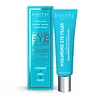What's inside
What's inside
 Key Ingredients
Key Ingredients

 Benefits
Benefits

 Concerns
Concerns

 Ingredients Side-by-side
Ingredients Side-by-side

Water
Skin ConditioningCetearyl Alcohol
EmollientGlycerin
HumectantCaprylic/Capric Triglyceride
MaskingCeteareth-20
CleansingDimethicone
EmollientPEG-8
HumectantPEG-8/Smdi Copolymer
Palmitoyl Myristyl Serinate
Skin ConditioningSodium Polyacrylate
AbsorbentButylene Glycol
HumectantOryza Sativa Bran Extract
Skin ConditioningTriethanolamine
BufferingNiacinamide
SmoothingSodium Hyaluronate
HumectantXanthan Gum
EmulsifyingPhenoxyethanol
PreservativeAcrylates/C10-30 Alkyl Acrylate Crosspolymer
Emulsion StabilisingDisodium EDTA
CI 19140
Cosmetic ColorantWater, Cetearyl Alcohol, Glycerin, Caprylic/Capric Triglyceride, Ceteareth-20, Dimethicone, PEG-8, PEG-8/Smdi Copolymer, Palmitoyl Myristyl Serinate, Sodium Polyacrylate, Butylene Glycol, Oryza Sativa Bran Extract, Triethanolamine, Niacinamide, Sodium Hyaluronate, Xanthan Gum, Phenoxyethanol, Acrylates/C10-30 Alkyl Acrylate Crosspolymer, Disodium EDTA, CI 19140
Water
Skin ConditioningGlycerin
HumectantCetearyl Alcohol
EmollientCeteareth-20
CleansingCaprylic/Capric Triglyceride
MaskingGlycol Cetearate
EmollientButyrospermum Parkii Butter
Skin ConditioningAloe Barbadensis Leaf Juice
Skin ConditioningSodium Hyaluronate
HumectantPersea Gratissima Oil
Skin ConditioningCamellia Sinensis Leaf Extract
AntimicrobialDiethylamino Hydroxybenzoyl Hexyl Benzoate
UV FilterEthylhexyl Methoxycinnamate
UV AbsorberEthylhexyl Salicylate
UV AbsorberEthylhexyl Triazone
UV AbsorberOctocrylene
UV AbsorberDi-C12-13 Alkyl Malate
EmollientDiisopropyl Adipate
EmollientAmmonium Acryloyldimethyltaurate/Vp Copolymer
Phenoxyethanol
Preservative1,2-Hexanediol
Skin ConditioningCaprylyl Glycol
EmollientCitric Acid
BufferingSodium Benzoate
MaskingPotassium Sorbate
PreservativeBHT
AntioxidantWater, Glycerin, Cetearyl Alcohol, Ceteareth-20, Caprylic/Capric Triglyceride, Glycol Cetearate, Butyrospermum Parkii Butter, Aloe Barbadensis Leaf Juice, Sodium Hyaluronate, Persea Gratissima Oil, Camellia Sinensis Leaf Extract, Diethylamino Hydroxybenzoyl Hexyl Benzoate, Ethylhexyl Methoxycinnamate, Ethylhexyl Salicylate, Ethylhexyl Triazone, Octocrylene, Di-C12-13 Alkyl Malate, Diisopropyl Adipate, Ammonium Acryloyldimethyltaurate/Vp Copolymer, Phenoxyethanol, 1,2-Hexanediol, Caprylyl Glycol, Citric Acid, Sodium Benzoate, Potassium Sorbate, BHT
Ingredients Explained
These ingredients are found in both products.
Ingredients higher up in an ingredient list are typically present in a larger amount.
This ingredient is an emollient, solvent, and texture enhancer. It is considered a skin-softener by helping the skin prevent moisture loss.
It helps thicken a product's formula and makes it easier to spread by dissolving clumping compounds.
Caprylic Triglyceride is made by combining glycerin with coconut oil, forming a clear liquid.
While there is an assumption Caprylic Triglyceride can clog pores due to it being derived from coconut oil, there is no research supporting this.
Learn more about Caprylic/Capric TriglycerideCeteareth-20 is an emulsifier and cleansing agent. It is derived from cetearyl alcohol, a fatty alcohol.
As an emulsifier, Ceteareth-20 prevents oil and water from separating. It is also a surfactant. Surfactants help gather oil, pollution, and dirt to be washed away.
Cetearyl alcohol is a mixture of two fatty alcohols: cetyl alcohol and stearyl alcohol. It is mainly used as an emulsifier. Emulsifiers help prevent the separation of oils and products. Due to its composition, it can also be used to thicken a product or help create foam.
Cetearyl alcohol is an emollient. Emollients help soothe and hydrate the skin by trapping moisture.
Studies show Cetearyl alcohol is non-toxic and non-irritating. The FDA allows products labeled "alcohol-free" to have fatty alcohols.
This ingredient is usually derived from plant oils such as palm, vegetable, or coconut oils. There is debate on whether this ingredient will cause acne.
Due to the fatty acid base, this ingredient may not be Malassezia folliculitis safe.
Learn more about Cetearyl AlcoholGlycerin is already naturally found in your skin. It helps moisturize and protect your skin.
A study from 2016 found glycerin to be more effective as a humectant than AHAs and hyaluronic acid.
As a humectant, it helps the skin stay hydrated by pulling moisture to your skin. The low molecular weight of glycerin allows it to pull moisture into the deeper layers of your skin.
Hydrated skin improves your skin barrier; Your skin barrier helps protect against irritants and bacteria.
Glycerin has also been found to have antimicrobial and antiviral properties. Due to these properties, glycerin is often used in wound and burn treatments.
In cosmetics, glycerin is usually derived from plants such as soybean or palm. However, it can also be sourced from animals, such as tallow or animal fat.
This ingredient is organic, colorless, odorless, and non-toxic.
Glycerin is the name for this ingredient in American English. British English uses Glycerol/Glycerine.
Learn more about GlycerinPhenoxyethanol is a preservative that has germicide, antimicrobial, and aromatic properties. Studies show that phenoxyethanol can prevent microbial growth. By itself, it has a scent that is similar to that of a rose.
It's often used in formulations along with Caprylyl Glycol to preserve the shelf life of products.
Sodium Hyaluronate is hyaluronic acid's salt form. It is commonly derived from the sodium salt of hyaluronic acid.
Like hyaluronic acid, it is great at holding water and acts as a humectant. This makes it a great skin hydrating ingredient.
Sodium Hyaluronate is naturally occurring in our bodies and is mostly found in eye fluid and joints.
These are some other common types of Hyaluronic Acid:
Learn more about Sodium HyaluronateWater. It's the most common cosmetic ingredient of all. You'll usually see it at the top of ingredient lists, meaning that it makes up the largest part of the product.
So why is it so popular? Water most often acts as a solvent - this means that it helps dissolve other ingredients into the formulation.
You'll also recognize water as that liquid we all need to stay alive. If you see this, drink a glass of water. Stay hydrated!
Learn more about Water